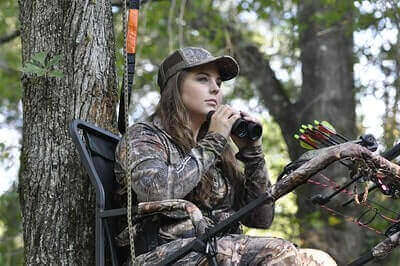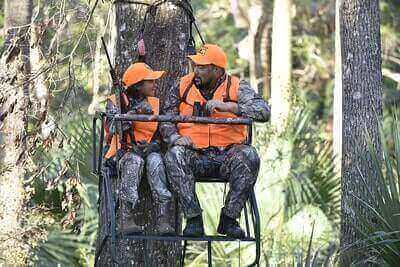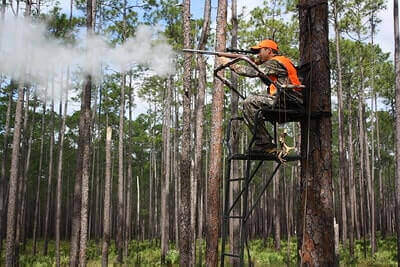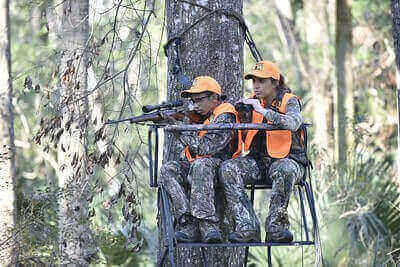Disclosure: We may earn commissions if you purchase products after clicking on a link from our site.
Do you know how to hunt from a tree stand? Hunting from a tree stand improves your chances of success. Hunting from a position above the animal’s line of sight as well as from your human scent coming in direct contact with a whitetail deer’s nostrils presents the best opportunity to land the buck you worked so hard all hunting season to get.
In this article, we will discuss how to hunt from a treestand as well as how to choose the right tree stand for your hunting location, how to set up your stand safely, and how to make the most of hunting from a tree stand.
Table of Contents
Types of Tree Stands
There are four main types of tree stands – the ladder, fixed position, climbing, and tree saddles.
1. Ladder Tree Stand
Ladder stands are designed with a ladder built as part of the tree stand. This design makes it easy for the hunter to climb into the tree stand without attracting much attention. With ladder tree stands, there are no other parts to assemble to the stand that may create noise that attracts the attention of deer.
Ladder tree stands are very sturdy and can be secured firmly to a tree. They usually are designed with large seats and side rails. You can also find ladder stands with an optional shooting rail that caters to rifle hunters. Bow hunters can also use a ladder stand by removing the shooting rail.
There are also some ladder tree stands that are designed for more than one person. This can be useful if you have a hunting buddy or you want to teach your child how to tree hunt.

2. Fixed Position Tree Stand
Fixed position tree stands are lighter than ladder or climbing stands. With fixed position stands, it is set up and remains set up for the entire hunting season. This makes it easy to use as you don’t have to take it down at the end of the hunting day.
Some fixed position stands are referred to as lock-on tree stands which are also called hang-on tree stands. If you have scouted the hunting area well and know the routes and behaviors of your target, hang-on stands can be very effective.
Lock-on tree stands can also be used by bow hunters. They are lighter than ladder stands making them easy to set up, take down and travel.
3. Climbing Tree Stand
Climbing tree stands are useful when you are not familiar with the hunting ground. With a climbing stand, you have the advantage to observe the hunting ground from a good vantage point. This helps you locate funnels, feed, and bedding spots. Climbing tree stands need the tree to few or be freed of limbs so your climbing can’t be obstructed. The best hunting ground blinds were reviewed and you can read it from this link.
4. Tree Saddles
Tree saddles are a type of tree stand that could be in another category all by itself. Tree saddles give you the ability to shoot in all directions as you are suspended and facing the tree. This also helps to give you cover and conceal you to some extent.

How To Hunt From A Tree Stand
1. Choose The Right Tree
Locate a tree that is sturdy and tall enough to give you a good vantage point. However, you don’t want it to be so tall that it can sway in the wind.
Choosing the right tree when hunting from a treestand is crucial for a successful and safe hunting experience. Hunters should look for sturdy trees with minimal branches that could obstruct their shooting lanes or cause noise when climbing or moving in the stand.
The selected tree should be large enough to support the weight of the hunter and the treestand securely. It’s essential to assess the surrounding terrain and vegetation to ensure the chosen tree provides adequate cover and concealment while still offering clear sightlines to potential game trails or feeding areas.
Additionally, hunters should consider the prevailing wind direction and position their treestand on the downwind side of where they expect the deer to approach, minimizing the risk of detection by their keen sense of smell. By carefully selecting the right tree based on these factors, hunters can increase their chances of success while remaining hidden and safe during their hunting excursion.
2. Place It At The Right Height
You will have to place your tree stand at the right height. This is a tricky one that is very important. It can’t be too high and neither can it be lower to the ground so that you can easily be spotted by your target. The acceptable height is 12 feet off the ground.
Placing the treestand at the right height is a critical aspect of successful hunting from a treestand. Hunters should aim to position the stand at a height that provides optimal visibility and shooting angles while minimizing the risk of detection by game animals.
Generally, a height of 15 to 20 feet above the ground is recommended, as it offers a good balance between visibility and concealment. However, the exact height may vary depending on factors such as the terrain, vegetation, and the type of game being hunted. It’s essential to consider the shooting range and trajectory of the weapon being used to ensure clear shots at potential targets.
Additionally, hunters should prioritize safety by selecting a sturdy and stable tree that can support the weight of the treestand and the hunter. By carefully assessing these factors and adjusting the height of the treestand accordingly, hunters can maximize their chances of success while hunting from a treestand.
3. Use a Safety Harness
Whenever you hunt from a tree stand, discipline yourself to use a safety harness. This is a very important safety measure that will prevent major injuries in case of a fall.
Using a safety harness is a crucial safety measure when hunting from a treestand. It helps prevent falls and reduces the risk of serious injury or even death. Hunters should always wear a safety harness properly and securely attached to the tree or the treestand itself.
Before ascending the tree, it’s essential to ensure that the harness is correctly fitted and adjusted for comfort and effectiveness. Throughout the hunt, hunters should remain connected to the tree at all times, even when climbing up or down. In the event of a slip or fall, the safety harness will arrest the descent, preventing a potentially dangerous drop to the ground.
Regular inspection of the harness for any signs of wear or damage is also crucial to ensure its reliability. By prioritizing the use of a safety harness, hunters can enjoy their time in the treestand with added peace of mind, knowing that they are protected against the inherent risks of hunting at elevated heights.
4. Wind Direction
When hunting from a tree stand, position yourself so that the wind is at your back. This prevents your human scent from being carried by the wind to the animals and alerts them.
Wind direction is a critical factor to consider when hunting from a treestand, as it can greatly affect the success of the hunt. Hunters should position their treestand downwind of where they expect the game to approach, allowing their scent to be carried away from the targeted area. This prevents animals from detecting the human scent and becoming wary, increasing the chances of a successful hunt.
Additionally, hunters should pay attention to subtle changes in wind direction throughout the hunt and be prepared to adjust their position accordingly. By strategically positioning the treestand concerning the wind direction, hunters can effectively conceal their presence and increase their chances of encountering game while hunting from a treestand.
5. Be Calm & Patient
One of the most overlooked tips for hunting from a tree stand is to remain calm and patient. Animals hear and see much better than we think. They can spot movement and pick up the slightest of sounds. You want to learn to be calm and patient when you hunt from a tree stand.
Remaining calm and patient is essential when hunting from a treestand. It’s easy to get excited when waiting for game to appear, but sudden movements or impatience can easily give away your position and spook potential targets. Hunters must maintain a relaxed demeanor, controlling their breathing and movements to minimize noise and avoid alerting nearby animals.
Patience is also key, as it may take some time for the desired game to approach. By staying calm and patient, hunters increase their chances of a successful hunt from a treestand, allowing them to blend seamlessly into the natural environment and wait for the perfect shot opportunity without disturbing the surroundings.
6. Your Clothing
You want to blend in with your surroundings and not give away your location to your target. For this reason, the clothing you wear is as important as any other tip for success in tree stand hunting. Camouflage clothing is the standard for not only tree stand hunting but hunting in general.
Choosing appropriate hunting clothing is crucial when hunting from a treestand. The clothing should provide both camouflage and comfort, helping the hunter blend into the surrounding environment while also keeping them warm and dry. Camouflage patterns should match the terrain and vegetation of the hunting area to break up the hunter’s outline and minimize detection by game animals.
Additionally, clothing should be selected based on the weather conditions, with options for layering to adjust for temperature changes throughout the day. It’s essential to wear quiet fabrics that won’t rustle or make noise when moving, as any sound could alert nearby animals.
Finally, clothing should be scent-free or treated with scent-blocking products to minimize the hunter’s odor, reducing the risk of detection by sensitive noses. By carefully selecting hunting clothing tailored to the specific conditions and environment, hunters can increase their chances of success when hunting from a treestand.
7. Practice, Practice & Practice
Always practice your shot many times before going out to hunt from a tree stand. You want to have a lot of practice so that it is second nature to get ready and take aim at your target. You want this to be easy and almost mechanical.
Practicing your shot is a critical factor when hunting from a treestand. Shooting from an elevated position presents unique challenges compared to shooting from ground level. The angle and distance can alter the trajectory of your shot, affecting accuracy and penetration. By practicing your shot from a treestand, you can familiarize yourself with these adjustments and refine your aim accordingly.
Additionally, practicing helps build confidence in your shooting abilities, which is essential for making clean and ethical kills. It also allows you to identify and correct any errors or inconsistencies in your shooting form, ensuring that you can make accurate shots when the opportunity presents itself during a hunt. Ultimately, regular practice improves your proficiency with shooting from a treestand, increasing your chances of success in the field while also promoting ethical hunting practices.

How To Find The Right Tree Stand
1. Height
When choosing a tree stand, you want to factor in its height. If you are hunting from ground level, you will want a tree stand that is tall enough to provide a clear viewpoint. If you are hunting from an elevated position, you want a tree stand that is not too high off the ground.
The height of the treestand is a crucial factor to consider when determining the right treestand for hunting. The optimal height depends on various factors, including the terrain, vegetation, and the type of game being pursued.
Generally, treestands are positioned at heights ranging from 15 to 30 feet above the ground to provide a strategic vantage point while minimizing the risk of detection by game animals. Higher treestands offer a broader field of view and may be advantageous for hunting in open areas or dense forests where visibility is crucial.
However, they also increase the difficulty of climbing and descending, as well as the potential for accidents. On the other hand, lower treestands are easier to access and offer a more stable platform for shooting but may limit visibility and shooting angles. Therefore, hunters should carefully assess the terrain and hunting conditions to determine the appropriate height for their treestand, balancing visibility, safety, and comfort to maximize their hunting success.
2. Weight
You want to be certain that the tree stand can support your weight and any gear that you carry. The weight of the treestand is an essential factor to consider when determining the right treestand for hunting.
The weight of the treestand affects its portability, ease of setup, and overall convenience during hunting expeditions. Lightweight treestands are preferable for hunters who need to transport their equipment over long distances or through rugged terrain. They are easier to carry and install, allowing hunters to quickly set up their stand in strategic locations without expending excessive energy.
Additionally, lightweight treestands are less likely to cause fatigue or strain on the hunter, enabling them to remain alert and focused during extended periods of hunting. However, heavier treestands may offer added stability and durability, particularly in adverse weather conditions or when accommodating larger hunters. Ultimately, hunters should select a treestand that strikes the right balance between weight and functionality, ensuring optimal performance and comfort throughout their hunting endeavors.
3. Price
Another factor to consider when choosing a tree stand is the price. You want to choose a tree stand that will make you successful in hunting from a tree stand but also be within your price range.
The price of the treestand is a significant factor to consider when searching for the right treestand. Treestands are available at various price points, ranging from budget-friendly options to high-end models with advanced features.
While budget constraints may influence the purchasing decision, it’s essential to strike a balance between cost and quality. Investing in a higher-priced treestand may offer benefits such as enhanced comfort, durability, and additional features like adjustable seats or noise-reducing technology.
However, budget-friendly options can still provide reliable performance for hunters on a tight budget. It’s crucial to assess the features and functionality offered by different treestands relative to their price to ensure that you’re getting the best value for your money.
Additionally, consider the long-term investment, as a higher-priced treestand may offer greater longevity and satisfaction over multiple hunting seasons. Ultimately, hunters should prioritize finding a treestand that meets their needs and budget while providing the necessary comfort and safety for successful hunts.
4. Easy To Set Up
You want a tree stand that is easy to set up and take down. You want to spend the least amount of time setting up a tree stand with the least amount of noise. A tree stand with a few parts to set up is more desirable.
The ease of setup of the treestand is a critical factor to consider when searching for the right one. Hunters often prefer treestands that are simple and straightforward to set up, especially if they frequently move between hunting locations or prefer to change their setup frequently.
A treestand with user-friendly features such as quick-attach straps, easy-to-follow assembly instructions, and minimal parts can significantly streamline the setup process, saving time and effort in the field.
Additionally, lightweight and portable treestands are favored for their ease of transportation and installation, particularly for hunters who venture into remote or rugged terrain. Conversely, treestands that are overly complex or cumbersome to set up may lead to frustration and inefficiency, detracting from the hunting experience. Therefore, hunters should prioritize treestands that offer hassle-free setup to maximize their time and focus on the hunt itself.

Tree Stand Hunting Safety Tips
1. Hunting Harness
Always wear a hunting harness to prevent serious injuries in case you fall. The hunting harness must be rated and should fit you properly. It should have a quick connect/disconnect system that allows you to safely attach and detach from the tree stand. You can read a review of the best hunting harnesses on the market today from this link.
2. Practice, Practice & Practice
Practice how to use the hunting harness. Do many repetitions of attaching and detaching from the tree stand. Always check your gear and make sure it is in operable condition before you set out on a tree stand hunt.
3. Unloaded Firearm
Always make sure your firearm is unloaded when you hunt from a tree stand until you are ready to shoot. An accidental discharge will be avoided when you climb or descend when your firearm is unloaded.
4. Plan For Emergencies
Always plan for emergencies. Be familiar with the surroundings and have multiple escape routes in case you need to get out quickly. Keep a fully charged phone, a map, and a compass with you.
5. Inform Someone of Your Plans
Always inform someone of your hunting plans and when you intend to return home. In case something happens, they may know where to start looking for you.
6. Follow Manufacturer Instructions
Follow the manufacturer’s instructions for setting up and using the stand. Doing this will ensure the tree stand is securely set up and this will prevent accidents.
7. Carrying Equipment
Never carry equipment with you when climbing. Always use a haul line to raise or lower your gear.

Setting Up Your Tree Stand
1. Find The Right Tree
You need to find a tree that is tall enough to give you a clear view of the hunting area. However, you don’t want a tree so tall that it sways in the wind and is difficult to climb and descend.
2. Attach The Stand To The Tree
Attach the tree stand to the tree using straps or bolts.
3. Secure Your Hunting Gear
Secure your hunting gear including binoculars, forearms, ammunition, etc. to the tree stand. The best hunting binoculars were reviewed to help you find the right one for your outdoor adventures and you can read it from this link.
4. Climb In
Climb into the tree stand and get ready to hunt.
Tree Stand Accessories
1. Lineman’s Rope
The lineman rope can be used for almost any task related to climbing your tree stand.
2. Fall Protection Tree Strap
The fall protection tree strap prevents you from serious injury in case of a fall.
3. Treestand Umbrella
The treestand umbrella helps shield you from direct sunlight or rain.
4. Treestand Storage Bag
The treestand storage bag stores your other gear.
5. Treestand Multi Hook Accessory Holder
The treestand accessory holder holds much of your gear.
The Bottom Line
Hunting from a tree stand gives a hunter more success than most other hunting methods. You are at an elevated position away from the target’s line of sight. Moreover, if you position yourself the right way in regard to the wind, the target will not pick up your scent and get alerted.
In this article, we discussed how to hunt from a tree stand, how to choose the right tree stand, how to set it up, and tree hunting safety tips. You can read about the best bow and gear hoists, the best tree stand harnesses, the best trail cameras, the best climbing treestands, and the best predator calls.